|
|
|
Sort Order |
|
|
|
Items / Page
|
|
|
|
|
|
|
| Srl | Item |
| 1 |
ID:
099552


|
|
|
| 2 |
ID:
134793
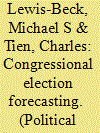

|
|
|
|
|
| Summary/Abstract |
In the United States, election forecasting has expanded from First Generation to Second Generation approaches. 1 The First Generation took hold in the early 1980s, and was dominated by a battle between structural modelers and pollsters (and to a lesser extent, the markets). The Second Generation, which had sunk deep roots by the 2012 presidential election, was dominated by Structuralists, Aggregators, Synthesizers, and Experts (as labeled by Lewis-Beck and Stegmaier 2014). The Structuralists continued in the tradition of issuing forecasts from static, single-equation explanatory models (e.g., Abramowitz 2014, Campbell 2014). The Aggregators departed from reliance on the polls of individual leading houses, instead freely combining many polls to come up with averaged, and dynamic, forecasts (e.g., Real Clear Politics). The Synthesizers joined structural models and poll aggregates to provide changing forecasts as Election Day approached (e.g., Erikson and Wlezien 2014; Linzer 2014). In contrast to this, The Experts, or Judges looked at whatever information they considered relevant, quantitative or not, arriving at forecasts shaped by current data and intuition (e.g., Cook and Wasserman 2014; Rothenberg 2014).
|
|
|
|
|
|
|
|
|
|
|
|
|
|
|
|
| 3 |
ID:
116457
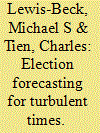

|
|
|
|
|
| Publication |
2012.
|
| Summary/Abstract |
Election forecasters face increasing turbulence in their relevant environments, making predictions more uncertain, or at least apparently so. For US presidential contests, economic performance and candidate profiles are central variables in most statistical models. These variables have exhibited large swings recently. Before the 2008 US presidential election, the economy fell into a Great Recession, and the candidate of one of the two major parties was, for the first time, a black man. These unprecedented conditions were trumpeted in the media, with heightened frenzy over the "horse race" question of who was going to win the White House. In the press, many forecasts appeared, taking different forms-polls, models, markets, pundits, to name some-offering a broader range of possible outcomes than ever before. Just looking at the predictions of the statistical modelers alone, we find that for 2008 many teams offered estimates of the incumbent (Republican) vote, ranging over an 11 percentage point spread. At one extreme, Lockerbie (2008) forecast 41.8% while at the other extreme Campbell (2008) forecast 52.7%. Of course, other methodologists offered their own, different, forecasts. The media, in its various forms, added to the hyperbole, aggressively reporting different forecasts on an almost daily basis.
|
|
|
|
|
|
|
|
|
|
|
|
|
|
|
|
| 4 |
ID:
116450
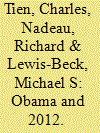

|
|
|
|
|
| Publication |
2012.
|
| Summary/Abstract |
Will President Obama lose votes in 2012 because of racial prejudice? For 2008, we estimated, via a carefully controlled, national survey-based study, that on balance he lost about five percentage points in popular vote share due to intolerance for his race on the part of some voters. What about 2012? There are at least three possibilities: (1) the presidency has become postracial, and the vote will register no racial cost; (2) intolerance has increased, and the vote will register an increased racial cost; and (3) intolerance has decreased, and the vote will register a decreased racial cost. Our evidence, drawn from an analysis comparable to that carried out for 2008, suggests Obama will pay a racial cost of three percentage points in popular vote share. In other words, his candidacy will experience a decrease in racial cost, if a small one. In 2008, this racial cost denied Obama a landslide victory. In the context of a closer election in 2012, this persistent racial cost, even smaller in size, could perhaps cost him his reelection.
|
|
|
|
|
|
|
|
|
|
|
|
|
|
|
|
| 5 |
ID:
096205
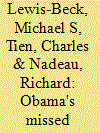

|
|
|
|
|
| Publication |
2010.
|
| Summary/Abstract |
Barack Obama was denied a landslide victory in the 2008 presidential election. In the face of economic and political woe without precedent in the post-World War II period, the expectation of an overwhelming win was not unreasonable. He did win, but with just a 52.9 percentage point share of the total popular vote. We argue a landslide was taken from Obama because of race prejudice. In our article, we first quantify the extent of the actual Obama margin. Then we make a case for why it should have been larger. After reviewing evidence of racial bias in voter attitudes and behavior, we conclude that, in a racially blind society, Obama would likely have achieved a landslide.
|
|
|
|
|
|
|
|
|
|
|
|
|
|
|
|
| 6 |
ID:
149326
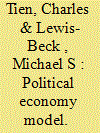

|
|
|
| 7 |
ID:
090222
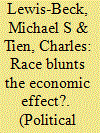

|
|
|
|
|
| Publication |
2009.
|
| Summary/Abstract |
In summer 2008, our Jobs Model forecast a Democratic presidential candidate two-party popular vote share of 56.6%, which would deliver the incumbent party the biggest defeat of any post-World War II contest (Lewis-Beck and Tien 2008). However, we argued, from our analysis of different experimental and observational evidence, that this unprecedented victory would be prevented by racially intolerant voters. We estimated the net racial cost of being a black candidate and corrected our overall forecast downward to 50.1% for Barack Obama. The unparalleled economic crisis, initiated after the release of our summer forecasts, prompted a reconsideration; the unique shock to the economy was no ordinary campaign perturbation. We calculated that the ensuing boost to anti-incumbent economic voting would add approximately two percentage points to the opposition; therefore, we issued a public revision of our forecast to 52.0 % for Obama (Lewis-Beck 2008). We are pleased that this final forecast fell so close to the actual result of 53.5%. Nevertheless, we contend the actual result should have been much closer to our original forecast. Given the dismal state of the polity and the economy prior to the election, the Obama victory should have been much bigger, as we show below.
|
|
|
|
|
|
|
|
|
|
|
|
|
|
|
|
| 8 |
ID:
100778
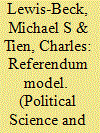

|
|
|
|
|
| Publication |
2010.
|
| Summary/Abstract |
Congressional election forecasting has experienced steady growth. Currently fashionable models stress prediction over explanation. The independent variables do not offer a substantive account of the election outcome. Instead, these variables are tracking variables-that is, indicators that may trace the result but fail to explain it. The outstanding example is the generic ballot measure, which asks respondents for whom they plan to vote in the upcoming congressional race. While this variable correlates highly with presidential party House seat share, it is bereft of substance. The generic ballot measure is the archetypical tracking variable, and it holds pride of place in the Abramowitz (2010) model. Other examples of such tracking variables are exposed seats or lagged seats, features of the Campbell (2010) model. The difficulty with such tracking models is twofold. First, they are not based on a theory of the congressional vote. Second, because they are predictive models, they offer a suboptimal forecasting instrument when compared to models specified according to strong theory.
|
|
|
|
|
|
|
|
|
|
|
|
|
|
|
|
|
|
|
|
|